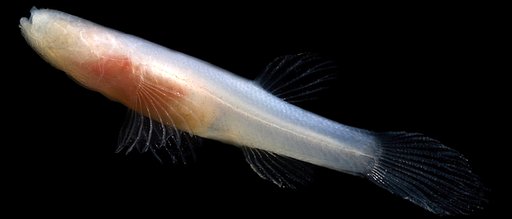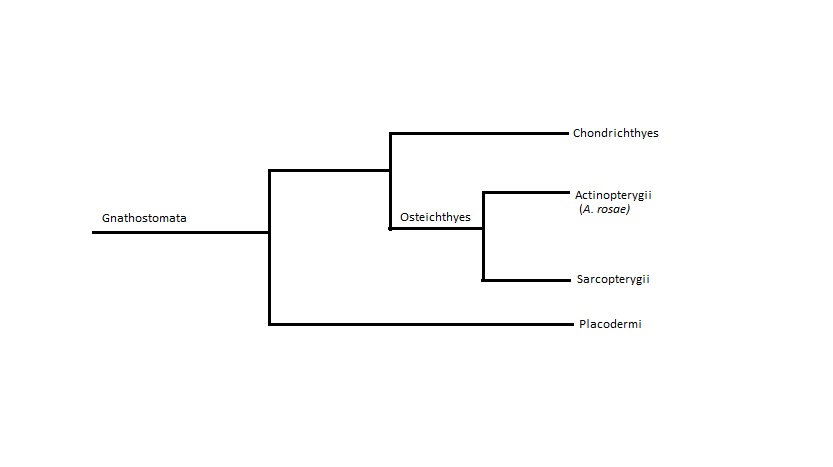
Classification
Domain – Eukarya
Kingdom – Animailia
Phylum – Chordata
Class – Actinopterygii
Order – Percopsiformes
Family – Amblyopsidae
Genus – Amblyopsis
Species – Amblyopsis rosae
Amblyopsis rosae is placed in the domain Eukarya because its cells have a true nucleus and membrane bound organelles. For the kingdom Animailia, the cavefish is a multicellular eukaryotic organism that is heterotrophic and lacks a cell wall, and is also found in the phylum Chordata due to the stipulations of a notochord (lengthy bundle of cells that forms that primary support structures in vertebrates) and being a deuterostome (the quality of developing the anus first in the gastrulation stage of development). Familiar Animalia include the lion (Panthera leo), the moose (Alces alces), and the blue whale (Balaenoptera musculus). The class of A. rosae is Actinopterygii and is defined as a species having ray fins where the webbing of the fins are supported by boney spines. Some well-known examples of Actinopterygii are the common shiner (Luxilus cornutues), the beluga sturgeon (Huso huso), and the pumpkinseed sunfish (Lepomis gibbosus). Its order is Percopsiformes because of its specific internal anatomical structure. Finally, the cavefish belongs to the family Ablyopsidae where it is placed with only one other organism where it meets the criteria of being a small freshwater fish that is found in dark cave environments and lacks functional eyes (Romero, A. & L. Bennis, 1998). The name Amblyopsis is adapted from the Latin terms "amblyo" meaning "dim" or "dull" and "opsis", meaning "of the eye," indicating the lack of vision in this species. It has been termed "rosae", meaning "roses", for it recognizable pink glow of visceral tissues underneath its transluscent epithelial tissues.
 Phylogenetic tree created by Alex Wontor
Phylogenetic tree created by Alex Wontor
In the above phylogenetic tree, it is shown that the closest relative to A. rosae is A. splaea. The two species are nearly indistinguishable other than the fact that they have different ranges that they are found in (Romero, A. & L. Bennis, 1998). The tree focuses on the family Amblyopsidae, of which there are currently only six different species of cavefish found in this particular family. The above tree is based on the occurrence of the gene responsible for rhodopsin which is a pigment of the eye that is responsible for the crude perception of light and dark (Woods L.P. & R.F. Inger, 1957).
 Phylogenetic
tree created by Alex Wontor
Phylogenetic
tree created by Alex Wontor
Shown above is a phylogenetic tree of A. rosae at the infraphylum superclass level. From this organizational level, the cavefish is a member of the class Actinopterygii which is defined by the presence of “fin rays” meaning that they have portions of skin webs that are stretched and suspended by boney spines. At this level of organization, the sister taxon of the Actinopterygii are the Sarcopterygii. This group is identified by the presence of lobed fins instead of fin rays. The level of organization in this tree is based strictly on the morphological appearance of the different species (Lobe-finned Fishes, 2013).